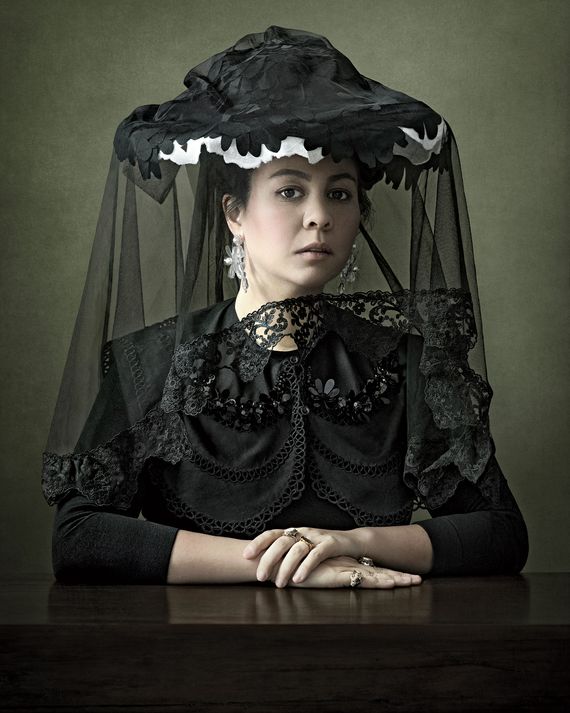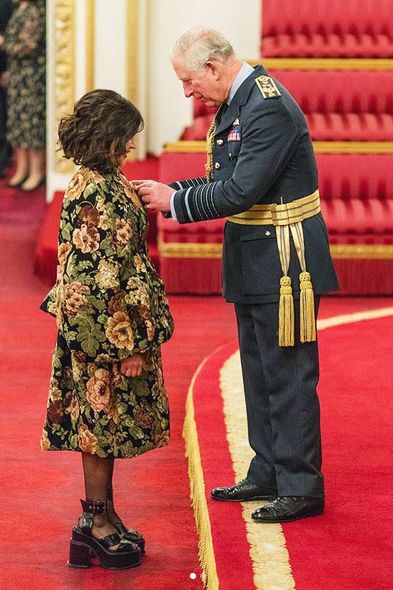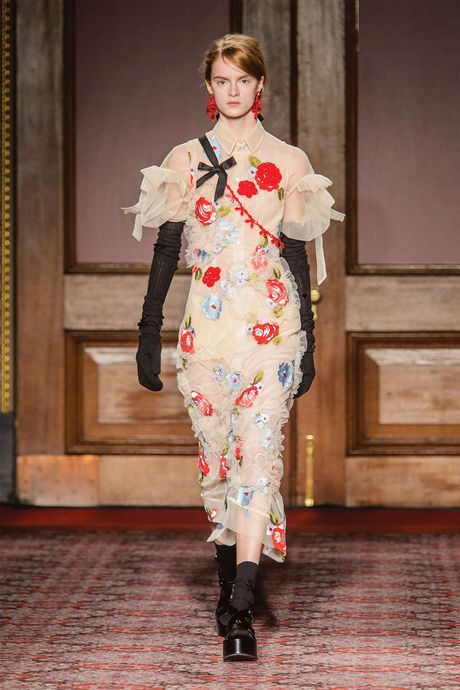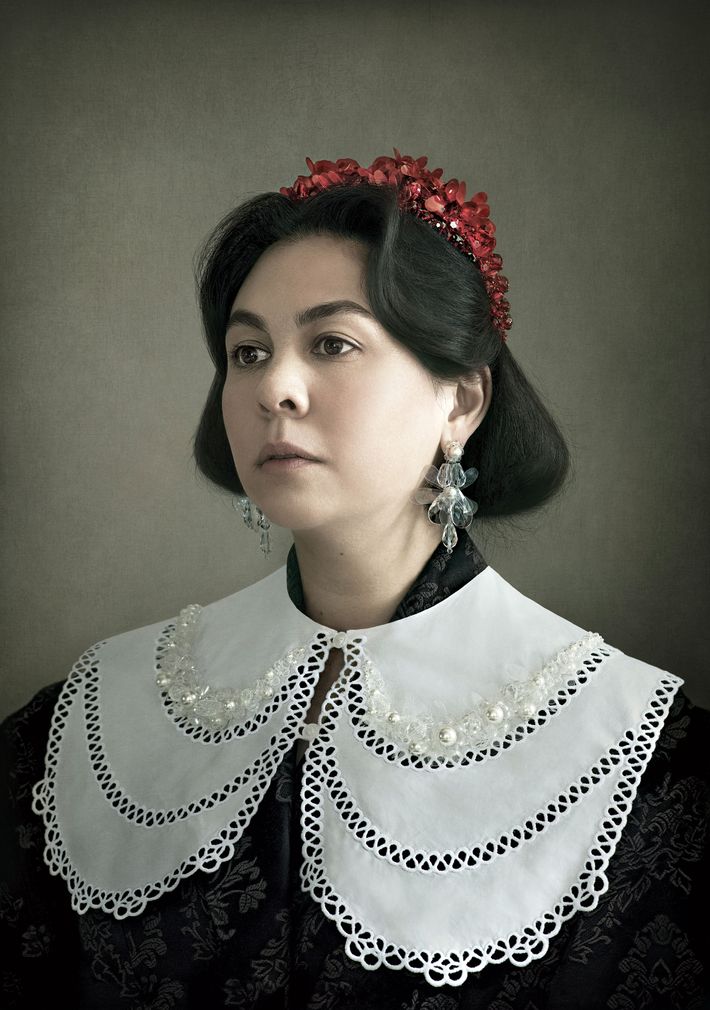
The British architect Farshid Moussavi, whose designs include the Museum of Contemporary Art Cleveland and the Yokohama International Port Terminal in Japan, recently wore a suit from Simone Rocha’s spring collection to receive the Order of the British Empire from Prince Charles. Done in a tapestry fabric worthy of ceremony — warm shades of green, pink, brown, and wine against black — it featured a dirndl skirt and a jacket with extravagantly puffed sleeves. But it wasn’t stiff: It looked both feminine and, in the best British tradition, comfy and tossed off, with the architect standing before the flush-faced royal in chunky platforms.
Moussavi first discovered Rocha’s clothes about seven years ago, soon after the designer’s London debut, and she likes to combine new and older pieces; her mother and teenage daughter wear the label too. “What interests me about her work is actually its endurance,” Moussavi says. “There is a timelessness about it, which runs at different levels. First, there are themes at work — femininity, effortlessness — but there is very little seasonality about them. And there is very little day and night. There are times in my work when I actually need to be more dressed during the day than the evening.”
A lot of other women, from millennials to Second Wave feminists, like it too: At 32, Rocha is one of the most successful young designers in the world, with flagship stores in London and New York and five years of profitability and double-digit growth. For various reasons — new gender attitudes, #MeToo, the realization that you absolutely can wear what you want to — more women now want to express themselves in more individual and even disruptive ways. From the start, Rocha has been cuing her audiences to what is pertinent in the culture and not merely impertinent on a runway, as so much of London Fashion Week’s theatricality is.
In 2012–13, fashion editors swooned over the spare, sharply drawn dresses and tailored office separates offered by a designer just two years out of art school, but the tapestry suit that Moussavi wore to Buckingham Palace, with its bubbly silhouette, is a good example of the huge stylistic leap Rocha has already made since then. She has a knack for layering ideas and concepts — a reference to an artist, or to a womenswear trend — onto classic feminine shapes produced in interesting fabrics, most of which she develops herself, heavy on solid blacks and reds, and all of it focused with a steely eye toward function.


Shortly after the New Year, I visited Rocha in her studio in De Beauvoir Town, an area of modest Victorian houses and newer flats set amid green spaces about three miles from Central London. De Beauvoir Town is also where Rocha lives with her partner, Eoin McLoughlin, a director of photography for films, and their 3-year-old daughter, Valentine. Their home is only a short walk to Rocha’s studio, which is in a low-rise industrial building on a quiet street next to Regent’s Canal. It was sunny and cold, and light from the large window flooded the studio’s book-lined, picture-strewn office, where I found Rocha.
“I haven’t gotten around to breakfast yet. Sorry!” she said cheerily, indicating a hard-boiled egg and dry toast, sealed in plastic, on her desk next to a stack of books on the work of her muse, Louise Bourgeois. (“You can tell Louise Bourgeois has always been on her mind,” says her friend Isabella Burley, the editor-in-chief of Dazed & Confused.)
Rocha is five-foot-four, with dark eyes, a round face, and a luxuriant head of black hair that she wears hectically pinned up. She had on a black sweater with a black tulle skirt covered with red flowers, Nikes, and long Edwardian diamond earrings. Her mother, Odette, who is Irish — her father, the designer John Rocha, is from Hong Kong — has the same thick hair, and together, the three generations of Rocha women look like absurdly beautiful royalty.
Last season, Rocha based her collection on feminine images and memories of Hong Kong, where she has many relatives (her dad is one of seven siblings) and visits twice a year, partly to see her biggest client, I.T, a retail conglomerate in the region. “The problem is, when I start a collection like that one, I always feel exposed by the end of it,” she says. “It’s more personal. I always feel a little sicky afterward.” She laughs. “Oh, it’s a killer! You want a cleanse. So this season I like this idea of peeping in on women rather than thinking about my aunties.”
For her show this month, Rocha is engaging directly with Bourgeois’s work — that is, she has permission from the Easton Foundation, which manages the artist’s archive and former home in Chelsea, New York, to translate drawings and other art into prints and three-dimensional pieces. “I always sound like a weird psycho, but I did my thesis in art college on her,” Rocha says. At that point, she didn’t have a career in mind. Still, ever since she discovered Bourgeois’s work, in an exhibit in Dublin of “Stitches in Time,” she’s felt a profound connection to Bourgeois’s body sculptures, studies of womanhood and sexuality, and background in tapestry (Bourgeois’s parents had a tapestry gallery in Paris, as well as a restoration workshop).
As Jerry Gorovoy, the president of the foundation, explained when I called him, Bourgeois in the mid-’90s started working with her childhood clothing and also items worn by her mother in the 1920s, which the artist had kept. “She wore Poiret and Chanel when she was a girl,” Gorovoy said. Some garments she kept whole and hung on poles, and others she later cut into strips and either wove together or formed into concentric circles. “She called them drawings, but they were all made of fabrics,” he said. The later ones are among the artworks that Rocha has adapted for exquisitely vivid, spiraling prints in red and white.
Gorovoy, who has known Rocha for a while, says, “I think she’s working out her connections with Louise, and I sensed that right away. She’s not just someone lifting a Mondrian and turning it into a dress. Louise is almost a starting point, but then it’s all Simone.” He added, “She’s sensitive. And she’s also very — I don’t know if shy is the right word, but she is tentatively moving. There’s something that’s very gentle about her.”
In her office, Rocha opened a monograph of Miroslav Tichý, a Czech photographer whose grainy images of young women, taken surreptitiously in the ’60s and ’70s as they sunbathed or gossiped in a park, were another source of inspiration. The pictures, taken with homemade cameras and deliberately scratched or underexposed, bring to mind a raw, naïve Garry Winogrand. (The Times, in a 2010 review, called Tichý’s work an “uncanny fusion of eroticism, paranoia and deliberation.”) “He was kind of a Peeping Tom,” Rocha said, then laughed. “My mom is like, ‘Ya can’t say Peeping Tom!’ ”
She paused over an image of an anonymous sunbather. “Do you know what’s interesting about it? It is that it’s not interesting. It’s the norm. There’s a naturalness about it. And I think the normalcy of it is also what makes it slightly provocative. It’s not like an Araki.”
Rocha was born in Dublin a year after her father began showing in London. He was part of a wave of innovative, street-inspired designers, led by Stevie Stewart and David Holah of Body Map, who ruled the runway in the era before Galliano and McQueen. Though she hung out in her dad’s studio and eventually helped with his shows, her interest in fashion was, at best, nonchalant. “She never shopped,” Odette told me. “She would take clothes from the sample rail, half-made. She would live in sweatpants. She would go out in an outfit, sleep in it, and go out the next day. There was absolutely no inclination of doing fashion. She wasn’t that type of girl at all. We expected her to do fine art.” You can understand why Rocha’s sense of femininity, from her second collection, which she showed with brogues, has always been grounded in reality and never looked conventionally ladylike or sugary.
“I was kind of a dosser,” admitted Rocha, using British slang for someone more interested in partying and boys than work. “But I could always come up with the goods.” Odette agreed: “She excelled at two subjects — art and music. And outside of that, she didn’t even try.” She laughed and said, “We can’t believe the same person can produce this work today and run a big studio — to us it’s pretty astonishing.”
Toward the end of art school, where Rocha took courses in textiles and various crafts including knitting, she decided to go into fashion. “The first thing [John and I] thought was, ‘Great! Maybe you’d like to join us,’ ” Odette told me. “Well, no way. She wanted to do her own thing.” Rocha applied to the two-year master’s program at Central Saint Martins in London, the school that had trained Galliano, McQueen, and Christopher Kane. The program was run by the late Louise Wilson, whose methods of grooming a student for the big leagues were comparable to a boot-camp sergeant’s. Rocha, who had spent a summer interning at Marc Jacobs, remembered her first meeting with Wilson. “I got a really good reference from Marc Jacobs, and she was, like, ‘Why did you get this reference?’ ” Wilson referred to one of Rocha’s Dublin teachers as “an old lesbian.” “Then she said, ‘I know who your dad is, and I don’t give a fuck.’ ”
Odette told me that “Louise Wilson, I have to say, was the making of Simone. She absolutely changed when she did the master’s under Louise. Now, it was hell. And I was so glad we weren’t in the same country. Because she might have quit.” Rocha’s main problem, as Wilson saw it, was that she had not developed a signature and her mind was not open enough. She’d say to her, “You need to go and look at The Night Porter. You need to go and look at some porn. And stop with the Irish references.”
Just before the Christmas break, Wilson told Rocha she would not be in the prestigious M.A. student show and should not even return for the next term. “I was, like, crying in my porridge,” Rocha said. “It was terrible.” She was stymied, in part, by not being a sketcher, which made it difficult for her to see an idea and then develop it. “I’m more of a maker,” she said. “So I started making clothes.” She worked hard on them over the break. She also realized around that time that if she photographed her fittings, she could then sketch over the print in order to see how to improve things. “That is how I still design today,” she said. “It was the only way I could get it down.” Wilson told Rocha she could stay.
Over a lunch of fish and chips at the Rochelle Bar & Canteen on the Mall in town, we started talking about her family. John Rocha, after almost three decades in fashion, stopped his mainline label around the time that his daughter launched hers, and today he mainly keeps an eye on production and long-term planning. He designed the company’s new distribution facility in Portugal in anticipation of Brexit. “Of course there are conflicts,” said Simone, who is sole owner. “The main conflict is that we’re really alike. We usually come to the same result, but because we’re both so headstrong it can take a while.” Odette works between the studio and the stores, looking for gaps in the offering. “She’s also our product checker,” Rocha said, smiling. “She’s like the mom. Is it good enough? Does it cover the knee? I can do whatever I like in the show, but I need to make sure the commercial is good enough to sit alongside the collection and even be good enough to be in the show.”
I asked Rocha how she met her partner. She let out a laugh. “I met him five years ago — through my dad. Very unsexy. We were both back in Ireland for Christmas. My dad was at a party with his friends, who are U2 — it was their Christmas dinner. So I came by. This young man walks in with long hair, and he quickly establishes that we’re the only people there under 55. I was, like, Eck. I was very mean.” She and McLoughlin got together back in London. “He’s an amazing dude, and we have a great time.”
Rocha has received offers for creative-director jobs at bigger houses, but given how rapidly the pendulum can swing in the luxury business, she has more reason than ever to be wary. (She’d be a good candidate to take over from Rei Kawakubo when the day comes, though — Rocha shares a similar sense of the weird with the great Japanese designer, inside a more commercial framework.) Besides, as Isabella Burley points out, Rocha has done something in England that seems worth banking on: “We’ve had so many great London designers, but how many of the younger ones have actually been able to build a real business? Well, for me, it’s Simone.”
Earlier in the day, at Rocha’s studio, we passed a trench coat waiting on a dress form for an adjustment. Rocha was thinking of opening the February show with it, since the slim fit, with a half-concealed ruffle in front, conveyed a sense of security and privacy. Other looks on the studio rails included coat-and-trouser combinations with a severe empire line, full skirts that combined tulle with a supersoft neoprene (“We haven’t used this quality before”), and dark satin jackets embedded with clumps of pouches in the same fabric, a 3-D technique often associated with Comme des Garçons. Then I noticed a demure, full-skirted dress in muted gold sequins — the basic Simone Rocha silhouette, except it was embroidered to look as if some of the sequins had been scraped off, not unlike the scratched photos of the peeping Tichý. And even if you knew none of that, it shows Rocha tilting her style slightly more to the glamorous this season: She’s never done an allover sequined dress before.
For Rocha, it’s all part of a dialogue with herself and her muses in an unfolding story that began with shapes as deceptively simple as paper dolls. “What I do comes from within, and it’s this idea of femininity. You can be a tomboy, a girlie-girl, a lesbian, you can be this or that, but you’re still a bird. I feel like, eck, all those emotions go into my clothes. I know I’m not a designer who has a cult, like Rick Owens. But I like to think that I can create something that women, at some point, can connect to. For me, that’s satisfying enough.” The cult may already be here.
*This article appears in the February 4, 2019, issue of New York Magazine. Subscribe Now!
More From The spring 2019 fashion issue
- A Fashion Historian Explains This Season’s Shoes
- This Season’s Monster Blazers Are Part David Byrne, Part Hillary Clinton
- A Trip to the Laundromat With 18 New Yorkers







